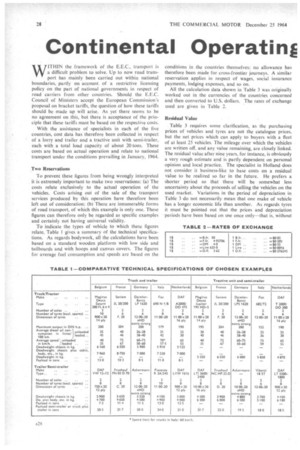Continental Operating ost s
Page 30

Page 31

If you've noticed an error in this article please click here to report it so we can fix it.
FIVE-COUNTRY COMPARISON OF SPECIFICATIONS, TAXES AND EXPENDITURE-BY R. BAKKER, Transport Advisory Department Unilever N.V. Rotterdam
'VVITH1N the framework of the E.E.C., transport is a difficult problem to solve. Up to now road transport has mainly been carried out within national boundaries, partly on account of a restrictive licensing policy on the part of national governments in respect of road carriers from other countries. Should the EEC. Council of Ministers accept the European Commission's proposal on bracket tariffs, the question of how these tariffs should be made up will arise, As yet there seems to be no agreement on this, but there is acceptance of the principle that these tariffs must be based on the respective costs.
With the assistance of specialists in each of the five countries, cost data has therefore been collected in respect of a lorry and trailer and a tractive unit with semi-trailer, each with a total load capacity of about 20 tons. These costs are based on actual operation and relate to national transport under the conditions prevailing in January, 1964.
Two Reservations To prevent these figures from being wrongly interpreted it is extremely important to make two reservations: (a) The costs relate exclusively to the actual operation of the vehicles. Costs arising out of the sale of the transport services produced by this operation have therefore been left out of consideration: (b) There are innumerable forms of road transport, of which this example is only one. These figures can therefore only be regarded as specific examples and certainly not having universal validity.
To indicate the types of vehicle to which these figures relate, Table I gives a summary of the technical specifications. As regards bodywork, all the calculations have been based on a standard wooden platform with low side and tailboards and with hoops and canvas covers. The figures for average fuel consumption and speeds are based on the conditions in the countries themselves: no allowance has therefore been made for cross-frontier journeys. A similar reservation applies in respect of wages, social insurance payments, lodging expenses, and so on.
All the calculation data shown in Table 3 was originally worked out in the currencies of the countries concerned and then converted to U.S. dollars. The rates of exchange used are given in Table 2.
Residual Value Table 3 requires some clarification, as the purchasing prices of vehicles and tyres are not the catalogue prices, but the net prices which can apply to buyers with a fleet of at least 25 vehicles. The mileage over which the vehicles are written off, and any value remaining, are closely linked. The residual value after nine years, for instance, is obviously a very rough estimate and is partly dependent on personal opinion and local practice. The specialist in Holland does not consider it business-like to base costs on a residual value to be realized so far in the future. He prefers a shorter period so that there will be somewhat less uncertainty about the proceeds of selling the vehicles on the used market. Variations in the period of depreciation in Table 3 do not necessarily mean that one make of vehicle has a longer economic life than another. As regards tyres it must be pointed out that the prices and depreciation periods have been based on use once only—that is, without
retreading and ignoring any resale value after 80,000 or 90,000 km.
To facilitate comparison as far as possible the cost of hypothetical journeys of 160 km. outward and 160 km. inward was calculated, using the basic data for each country and each type of vehicle. The full journey is considered to be made in -one day, five days a week and 50 weeks each year; this makes a total of 80,000 km. per year (2 x 160 x 5 x 50 = 80,000).
The Driver The results of these calculations can be found in Table 4. The distance of 160 km. was chosen, as at an average speed of 44) kin.p.h. this gives exactly eight driving hours per day. In all of the countries except Italy a journey of this nature can be made by one driver. It is assumed that any load carried is palletized, and that mechanical aids are used for loading and unloading. It is also assumed that the driver has no concern with or responsibility for lOading and unloading, so that the time this takes up does not count as working time for him. annual amount of interest is calculated according to the formula:
Where I = annual amount of interest, P purchase price of vehicles (including tyres) and R = residual value.
(b) The annual taxes are those levied on the vehicle and independent of the extent to which the vehicle is used. Where-the tax rates distinguish between ancillary operation and professional haulage (in France, for instance) the rate for professional haulage is adopted.
(c) By maintenance is meant the normal cleaning of the vehicles, and occasional paintwork.
(d) The wages relate exclusively to the drivers. In Italy it is prescribed by law that there must always be two drivers in the cabin; in other countries one driver is enough. The amounts given for wages include additions for customary bonuses, holidays, sickness, special leave, and so on, as well as the wages of a replacement during the normal driver's absence.
(e) Social insurance comprises only the share that has to be borne by the employer. This varies from country to country, as follows (shown as a percentage of the basic wage): Belgium 25,30; France, 50.00; Germany 15.88; Italy 38.84; and Holland 21.00.








































































